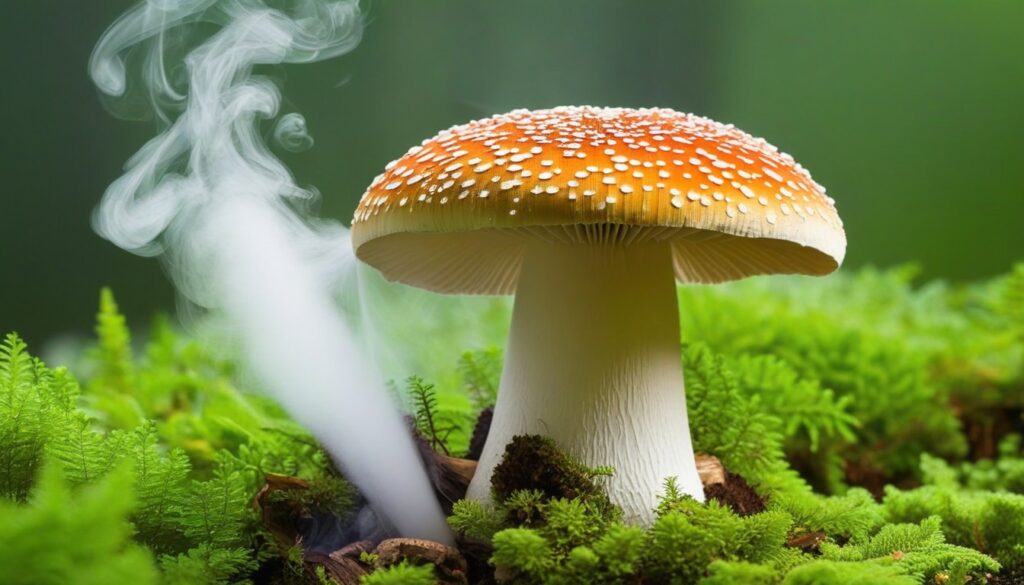Are you interested in growing mushrooms at home? Then, you must ensure that your mushroom growing environment is optimal. One of the essential components of a perfect growing environment for mushrooms is humidity. Mushroom cultivation requires specific humidity levels that can be challenging to maintain without a reliable humidifier.
If you want to ensure that your mushroom cultivation is successful, you need to choose the right humidifier. In this article, we’ll explore everything you need to know about using a humidifier for mushroom cultivation. From understanding the importance of humidity to choosing the right humidifier and using it effectively, we’ve got you covered.
Key Takeaways
- Humidity is a crucial factor in successful mushroom cultivation.
- A reliable humidifier can help maintain optimal humidity levels.
- Choosing the right humidifier is essential for successful mushroom cultivation.
- Proper usage and maintenance of the humidifier are crucial.
- Maintaining optimal humidity levels is vital for optimal mushroom growth and yield.
Why is a Humidifier Important for Mushroom Cultivation?
Mushroom cultivation is a delicate process that requires precise environmental conditions. Maintaining optimal humidity levels is crucial for ensuring successful mushroom growth. A humidifier can play a pivotal role in creating the ideal conditions for mushroom cultivation.
Humidifiers provide a range of benefits that can facilitate mushroom cultivation. Some of the benefits of using a humidifier for mushroom cultivation include:
- Preventing Drying Out: Mushrooms need moisture to grow, and low humidity levels can cause them to dry out and become stunted. A humidifier helps to maintain the necessary moisture levels and prevent drying out.
- Supporting Mycelium Growth: Adequate humidity levels foster the growth of mycelium, which is essential for the formation of mushroom fruiting bodies. A humidifier can help provide the necessary moisture to support mycelium growth.
- Preventing Contamination: High humidity levels aid in reducing the potential for contamination, which is a major risk in mushroom cultivation. A humidifier can help maintain a clean and sterile environment, reducing the risk of contamination.
- Optimizing Growing Conditions: Different mushroom species require specific humidity levels for optimal growth. A humidifier can provide versatile humidity control, allowing you to adjust and maintain the ideal humidity levels for your mushroom species.
Overall, using a humidifier for mushroom cultivation can support healthy and efficient growth, improve yields, and reduce the risk of contamination. It is an essential tool for achieving the optimal growing conditions necessary for successful mushroom cultivation.
Factors to Consider When Choosing a Humidifier for Mushroom Cultivation
When it comes to choosing a humidifier for mushroom cultivation, there are various factors to consider to ensure that you get the best one for your needs. Consider the following factors:
Mushroom Growing Requirements
First and foremost, it is essential to understand the humidity requirements of the mushroom species you are growing. Different types of mushrooms have different ideal humidity levels that need to be maintained for successful cultivation. For example, Shiitake mushrooms require 85-90% humidity, while Oyster mushrooms need 65-75% humidity. Understanding these requirements will help you choose a humidifier that can meet the specific needs of your mushrooms.
Humidity Control
The next factor to consider is the level of control the humidifier offers. Look for a humidifier that allows you to adjust the humidity levels according to the requirements of your mushrooms. A humidifier with an adjustable humidistat is ideal since it can maintain the desired humidity levels automatically and prevent over-humidification, which can lead to mold growth and other issues.
Choosing a Humidifier
When choosing a humidifier for mushroom cultivation, it’s essential to consider the size of your growing space. Ensure that the humidifier you choose can provide enough moisture to cover the entire growing area effectively. Portable humidifiers with wheels are a great option since they are easy to move around and can cover a larger space if necessary.
Maintenance
Another crucial factor to consider when choosing a humidifier is maintenance. Look for a humidifier with easy-to-clean parts that can be disassembled and reassembled with ease. Avoid humidifiers with hard-to-reach components that may require professional cleaning since this can be costly and time-consuming.
By considering these factors, you can choose a humidifier that meets the specific requirements of your mushroom cultivation needs and ensure that your mushrooms grow optimally and healthily.
Types of Humidifiers Suitable for Mushroom Cultivation
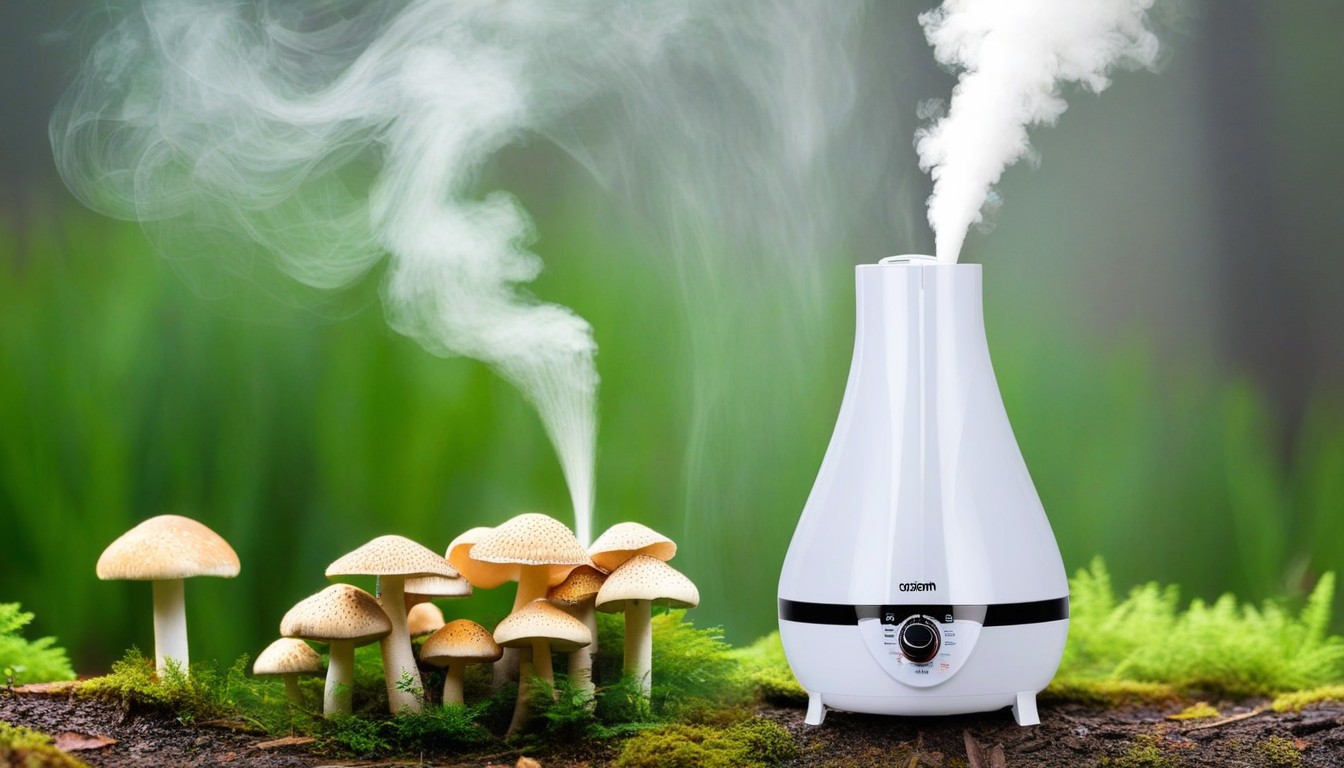
When it comes to choosing a humidifier for mushroom cultivation, there are different types of humidifiers available in the market with varying features and functions. It is important to understand the different options to make an informed decision based on your specific mushroom growing requirements. Here are the common types of humidifiers suitable for mushroom cultivation:
Ultrasonic Humidifiers
Ultrasonic humidifiers use high-frequency vibrations to produce a fine mist of water droplets. These humidifiers operate quietly and are typically energy-efficient. Ultrasonic humidifiers are ideal for mushroom growing environments where noise levels need to be kept low. They are also known for producing a cool mist, which is preferable for some mushroom species that grow better in cooler environments.
Evaporative Humidifiers
Evaporative humidifiers work by using a fan to blow air through a wet wick or filter. This process evaporates the water and increases the humidity in the environment. These humidifiers are low maintenance and do not produce mineral build-up like other types of humidifiers. However, they may not be ideal for mushroom growing environments where water quality is an issue.
Cool Mist Humidifiers
Cool mist humidifiers work by using a fan to blow air through a filter or wick that has been soaked in water. The air passing through the wet filter picks up moisture and blows it into the mushroom growing environment. Cool mist humidifiers are ideal for mushroom growing environments that require cooler temperatures, as they do not produce heat. These humidifiers are also easy to clean and do not have any mineral build-up issues.
Warm Mist Humidifiers
Warm mist humidifiers use a heating element to boil water, creating steam that is released into the air. These humidifiers are ideal for mushroom growing environments where warmer temperatures are required, as they produce heat. They are also effective in killing bacteria and other microorganisms in the water, making them ideal for environments where water quality is an issue. However, they require more maintenance and cleaning compared to other types of humidifiers.
When choosing a humidifier for mushroom growing, consider the specific requirements of your mushroom species and the environment. Also, keep in mind the maintenance and cleaning requirements of each type of humidifier to ensure optimal performance and longevity of the equipment.
Features to Look for in a Humidifier for Mushroom Growing
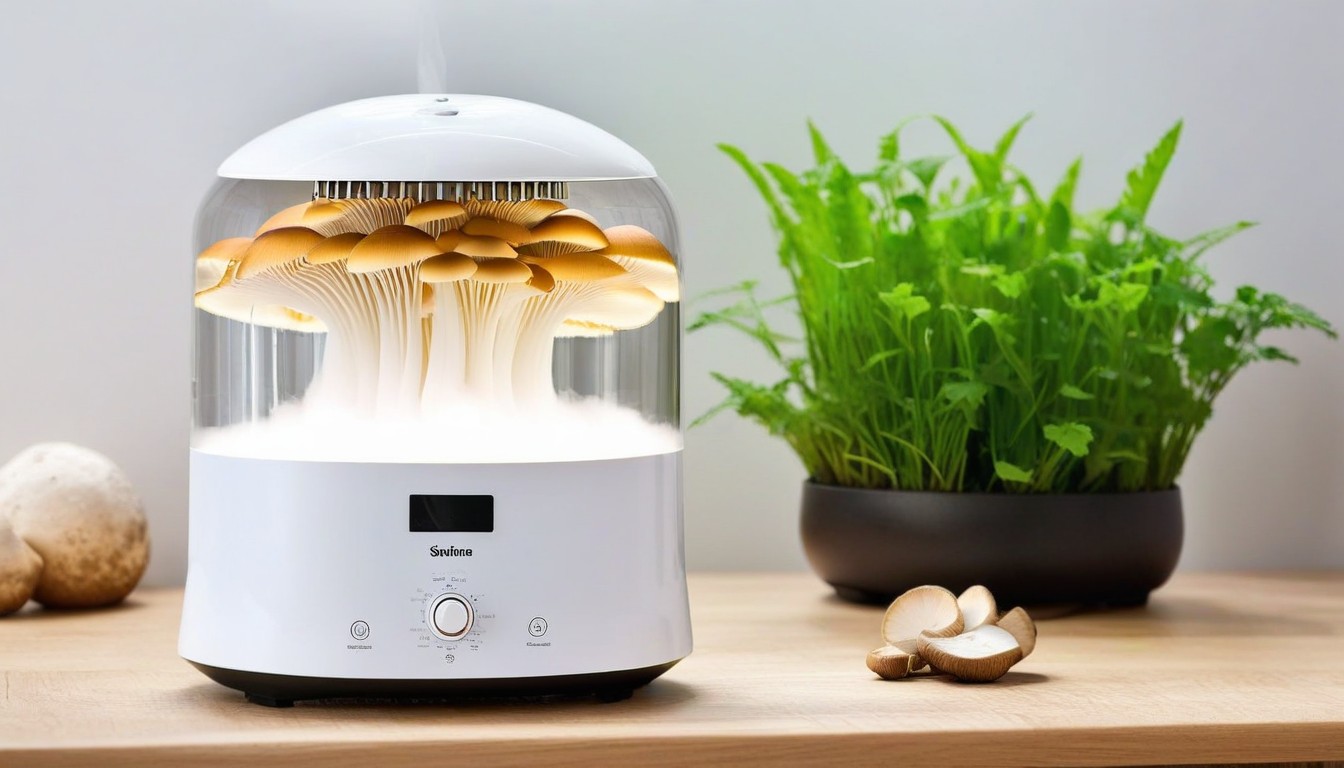
When it comes to growing mushrooms at home, maintaining the right humidity level is essential for their growth and development. A suitable humidifier can help achieve this goal, but what features should one look for in a humidifier specifically designed for mushroom cultivation? Here are some must-have functions to consider:
- Adjustable humidity settings: A good humidifier for mushroom growing should have adjustable humidity settings to help maintain the optimal level required for different stages of mushroom cultivation.
- Automatic shut-off: This is a safety feature that turns off the humidifier when the water level is low. It helps prevent overheating and damage to the humidifier.
- Easy maintenance: A humidifier that is easy to clean and maintain is always a plus. Look for humidifiers that have removable tanks, filters, and accessible nooks and crannies to make cleaning a breeze.
- Noise level: Mushroom cultivation requires a quiet, peaceful environment. Choose a humidifier that produces minimal noise to avoid disrupting the growth process.
- Size and capacity: The size of the humidifier should be suitable for the growing space. It should not be too large or too small. The water tank capacity should also be enough to last for at least a day or more.
- Durability: Choose a humidifier made of durable materials that can withstand frequent use. This ensures long-lasting performance and value for your money.
Why These Features are Essential for Mushroom Cultivation
Apart from maintaining optimal humidity levels, using a humidifier with the features listed above makes the process of growing mushrooms more efficient and hassle-free. Adjustable humidity settings allow you to maintain the right level of humidity that is required for each stage of growth, ensuring your mushrooms get the best conditions to thrive.
An automatic shut-off function prevents the humidifier from running dry, which can cause damage to the humidifier and create fire hazards. This safety feature allows you to rest easy, knowing that your humidifier is safeguarded.
Easy maintenance features ensure that you can keep your humidifier clean, free from mold and bacteria, and running smoothly. A noisy humidifier can be a distraction or cause stress to your growing mushrooms; therefore, a quiet humidifier is essential.
The size and capacity of the humidifier should match the growing space and requirements. A small humidifier in a large space would not be effective, while a large humidifier in a small space would be overkill. Durability ensures that the humidifier can withstand the rigors of frequent use and last for years, making it a wise investment.
Considering these features will help you choose the most suitable humidifier for your mushroom growing needs. Finding a humidifier with these features can make the process of growing mushrooms at home a breeze and provide you with a successful yield.
Best Humidifiers for Growing Mushrooms
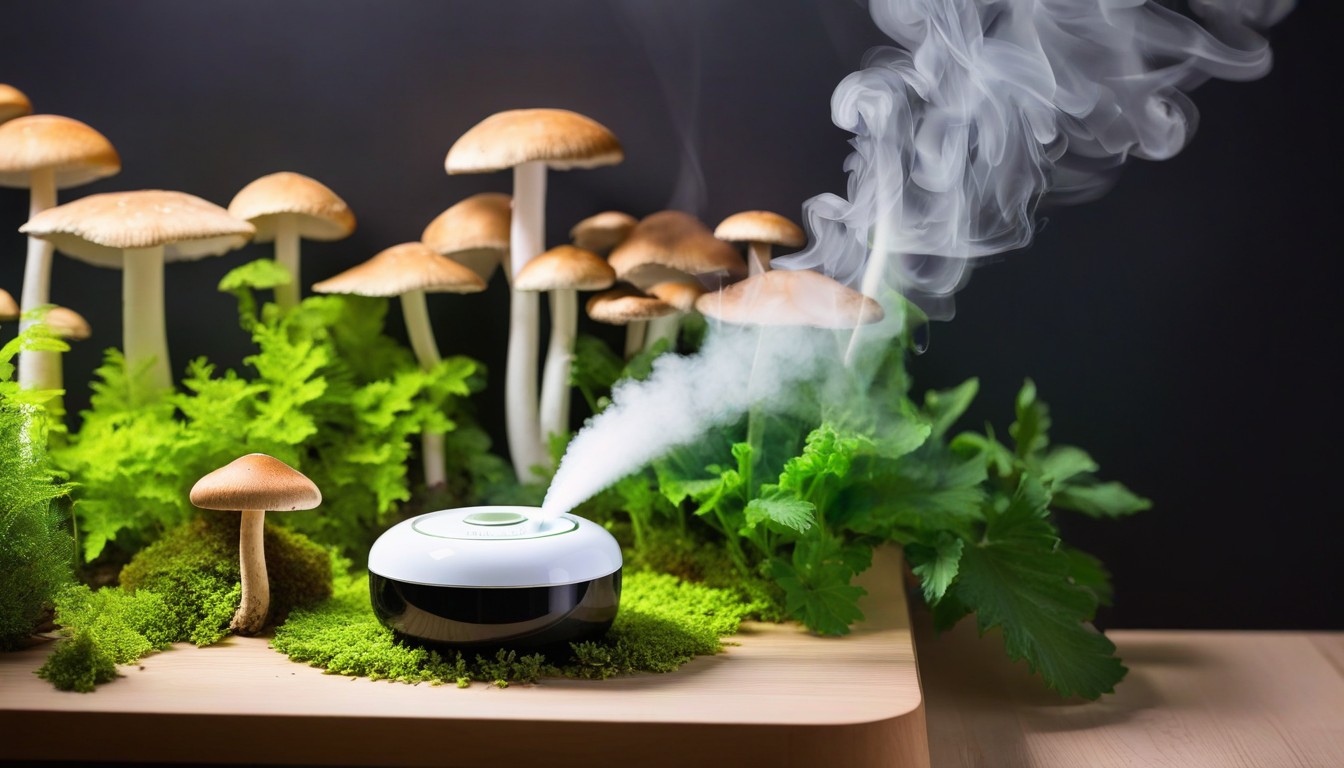
Choosing the right humidifier is crucial for successful mushroom cultivation at home. Here are some of the top humidifiers recommended by experts:
|
Humidifier |
Brand |
Rating |
|---|---|---|
|
Ultrasonic Cool Mist Humidifier |
Everlasting Comfort |
4.5/5 |
|
Evaporative Humidifier |
Vornado |
4/5 |
|
Cool Mist Humidifier |
Pure Enrichment |
4.5/5 |
|
Ultrasonic Humidifier |
Pure Enrichment |
4/5 |
These humidifiers are among the best-rated models for mushroom cultivation and offer quality features for optimal humidity control. Brands such as Everlasting Comfort and Pure Enrichment are recommended for their reliable performance, ease of use, and affordable prices.
When selecting a humidifier, consider the size of your growing area, the type of mushrooms you are growing, and your budget. It is also essential to ensure that the humidifier has adjustable humidity levels, automatic shut-off, and a large water tank capacity.
A good humidifier can provide the ideal humidity conditions for mushroom growth, ensuring that your mushrooms thrive and produce a plentiful harvest.
Tips for Using a Humidifier Effectively in Mushroom Cultivation
If you’re using a humidifier for mushroom cultivation, it’s crucial to use it effectively to ensure successful growth. Here are some tips to help you:
1. Proper Placement
Place the humidifier close to the mushrooms, but not so close that it directly sprays on them. This will prevent water droplets from forming on the mushrooms, which can lead to contamination.
2. Humidifier Settings
Set the humidifier to the appropriate humidity level based on the mushroom growing technique you’re using. Different mushrooms require different humidity levels, so make sure you understand the needs of your specific mushroom species.
3. Humidity Control
Regularly monitor the humidity level in your growing environment using a hygrometer. Adjust the humidifier settings accordingly to maintain the desired humidity range.
4. Cleaning and Maintenance
Clean your humidifier regularly to prevent the buildup of bacteria or mold that can harm your mushrooms. Follow the manufacturer’s instructions for cleaning and maintenance, and replace the filter as needed.
5. Mushroom Growing Techniques
Use mushroom growing techniques that complement your humidifier usage. For example, if you’re using a misting humidifier, consider misting your mushroom trays or bags in between humidifier cycles to enhance moisture levels.
6. Humidity Strategies
Experiment with different humidity strategies to find what works best for your mushroom species and growing environment. This could include using a combination of humidifiers, alternative humidity management methods, or adjusting lighting or ventilation to impact humidity levels.
By following these tips for using a humidifier effectively in mushroom cultivation, you’ll be on your way to growing healthy, abundant mushrooms at home!
Maintaining Proper Humidity Levels in a Mushroom Growing Environment
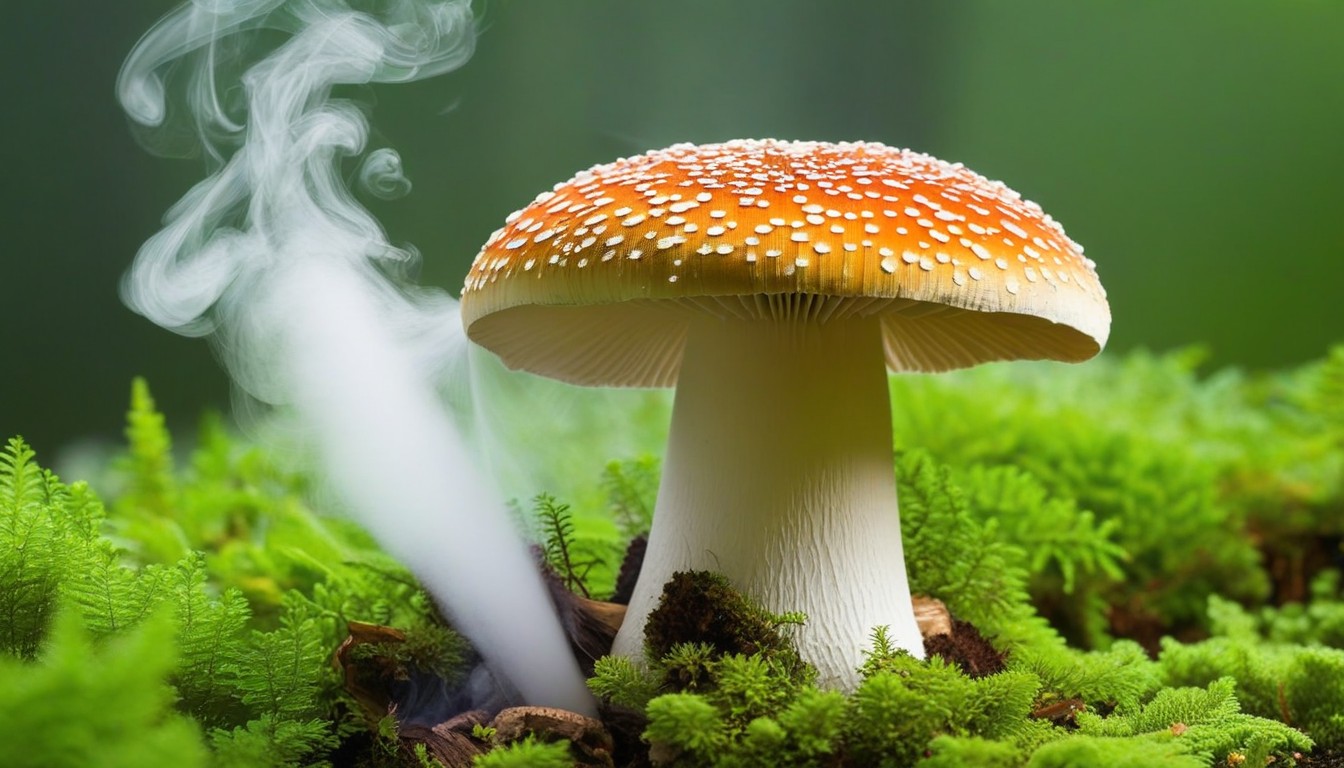
Maintaining proper humidity levels in your mushroom growing environment is crucial for successful mushroom cultivation. Humidity affects both the growth and development of mushrooms and the prevention of contamination.
Optimal humidity levels vary slightly depending on the species of the mushroom, but generally, the ideal humidity range is between 75% to 85%. It’s important to note that too high or too low humidity levels can cause problems such as mold growth, stunted growth, or even death of the mushroom.
Using a humidifier is an effective way to manage humidity levels, but it’s essential to use it correctly. Place the humidifier near the mushrooms, ensuring that it does not directly blow on them to avoid unwanted drafts.
Regularly check the humidity levels using a hygrometer and adjust the humidifier settings to maintain the optimal level. It’s also important to clean the humidifier regularly to prevent the growth of bacteria or mold that can negatively impact mushroom growth.
Additional Techniques for Humidity Management
Apart from using a humidifier, there are other techniques you can use to manage humidity levels in your mushroom growing environment.
- Use a spray bottle to mist the mushroom substrate with water to increase the humidity level.
- Place a tray of water near the mushrooms to increase humidity levels by evaporation.
- Cover the mushroom growing container with plastic wrap to trap moisture and increase humidity.
These techniques can be helpful in maintaining proper humidity levels, but they may not provide as consistent or controlled of an environment as a humidifier.
It’s important to monitor humidity levels regularly and adjust your chosen technique accordingly to ensure optimal growing conditions.
Troubleshooting Common Issues with Humidifiers in Mushroom Growing
While using a humidifier can certainly create an optimal growing environment for your mushrooms, it’s important to understand that it may also come with some common issues. Knowing how to troubleshoot these problems can help you avoid potential setbacks in your mushroom cultivation.
Humidifier Troubleshooting
One of the most common problems you may face with a humidifier is mold growth. To avoid this, make sure to clean your humidifier regularly and change the water frequently. If mold growth does occur, you may need to deep clean your humidifier with vinegar or hydrogen peroxide.
Condensation is another potential issue that may arise when using a humidifier. To prevent this, make sure to properly ventilate your growing area and avoid over-humidifying.
Excessive humidity can also pose a challenge, which may stunt or even kill your mushrooms. Make sure to monitor humidity levels regularly and adjust your humidifier settings as needed to maintain the ideal range.
Mushroom Growing Challenges
In addition to issues directly related to the humidifier, there may also be other challenges you face when growing mushrooms at home. For example, temperature control can be essential for successful mushroom cultivation. Make sure to keep your growing area at the appropriate temperature range and avoid extreme fluctuations.
Another challenge can be contamination, which may occur from outside sources or improper sanitation practices. To minimize the risk of contamination, make sure to thoroughly clean and sanitize all equipment and materials before use and avoid introducing any foreign substances to your growing area.
Humidity-Related Problems
When it comes to humidity-related problems, it’s important to understand that maintaining consistent humidity levels is key. A lack of humidity can cause your mushrooms to dry out and fail to grow, while excessive humidity can lead to mold growth and other issues.
To avoid these problems, make sure to regularly check and adjust your humidifier settings as needed, and consider additional tools such as fans or dehumidifiers to help manage humidity levels.
Alternative Methods for Managing Humidity in Mushroom Cultivation
While using a humidifier is the most convenient and efficient way to maintain optimal humidity levels for mushroom cultivation, there are alternative methods you can explore. These methods can be especially useful if you don’t have access to a humidifier or if you want to try other techniques for managing humidity.
Misting Technique
The misting technique involves using a spray bottle to mist your mushroom growing area with water. This can help increase the humidity levels in the air and keep the substrate moist. However, it’s essential to avoid using too much water as it can lead to over-saturation and cause mold growth.
Perlite Trays
Perlite trays are made of porous volcanic glass that can absorb water and release it back into the air. Simply fill a tray with perlite and add water to the bottom of the tray. Place your mushroom growing containers on top of the perlite tray and allow the moisture to evaporate into the air, increasing humidity levels.
Wet Towels
Wet towels can help maintain humidity levels in your mushroom growing environment. Simply dampen a towel and hang it near your mushroom containers, making sure it doesn’t touch them. The water from the towel will evaporate into the air, increasing humidity levels. Remember to keep the towel damp and avoid using too much water.
Ventilation
Ventilation is essential for ensuring proper air exchange and preventing excessive humidity levels. Use a fan or open a window to allow fresh air to circulate in your growing area. This can help reduce moisture and prevent mold growth.
Conclusion
As you can see, a humidifier is a crucial tool for growing mushrooms at home. Maintaining optimal humidity levels is essential for the successful cultivation of mushrooms, and a good humidifier can help you achieve this.
Explore Your Options
If you’re serious about growing mushrooms, it’s important to invest in a humidifier that meets your needs. Consider the factors we’ve discussed, such as the type of humidifier and the features it offers, before making your decision.
Don’t Forget About Maintenance
Once you’ve chosen your humidifier, it’s important to maintain it properly. Regular cleaning and upkeep will ensure your humidifier continues to function optimally and provides the necessary humidity levels for your mushrooms.
Experiment with Different Techniques
Remember, growing mushrooms is a science and an art. While a humidifier is an essential tool, there are other ways to manage humidity in your growing environment. Don’t be afraid to experiment with different techniques and find what works best for you.
At the end of the day, the key to successful mushroom cultivation is consistency and attention to detail. With the right tools, techniques, and mindset, you can enjoy a bountiful harvest of delicious mushrooms grown right in your own home.
FAQ
What is the best type of humidifier for mushroom cultivation?
The best type of humidifier for mushroom cultivation depends on various factors such as the size of your growing area, your specific mushroom growing requirements, and your personal preferences. Ultrasonic humidifiers, evaporative humidifiers, and cool mist humidifiers are all popular options to consider.
How do I choose the right humidifier for mushroom growing?
When choosing a humidifier for mushroom growing, it is important to consider factors such as the size of your growing area, the specific humidity requirements of your mushroom species, the level of humidity control offered by the humidifier, and any additional features that may enhance your growing experience.
What features should I look for in a humidifier for mushroom cultivation?
Some important features to look for in a humidifier for mushroom cultivation include adjustable humidity settings, automatic shut-off for safety, easy maintenance and cleaning, and a tank capacity suitable for your growing needs. It is also beneficial to choose a humidifier with a quiet operation.
How do I effectively use a humidifier in mushroom cultivation?
To effectively use a humidifier in mushroom cultivation, it is crucial to place the humidifier in the appropriate location within your growing area, monitor and adjust humidity levels as needed, and follow proper maintenance and cleaning practices to ensure optimal performance.
How can I troubleshoot common issues with humidifiers in mushroom growing?
Common issues that may arise with humidifiers in mushroom growing include mold growth, condensation, and excessive humidity. To troubleshoot these problems, it is important to adjust humidity settings, ensure proper ventilation, and follow proper cleaning and maintenance routines.
Are there alternative methods for managing humidity in mushroom cultivation?
Yes, apart from using a humidifier, there are alternative methods for managing humidity in mushroom cultivation. These include using perlite trays to create a humid microclimate, using wet towels or trays of water for moisture, or employing misting techniques to maintain the desired humidity levels.

